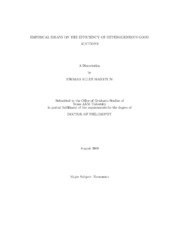| dc.description.abstract | A recent pursuit of the auction design literature has been the development of
an auction mechanism which performs well in a multi-good setting, when the goods
are not substitutes. This work began in earnest with the Federal Communications
Commission spectrum license auctions in the early nineties and continues to this day.
In a setting in which goods are not substitutes, the value of one good depends nonnegatively
on the quantities of other goods that are won. This type of interdependent
value structure has proven difficult to account for in auction design. However, the
need for mechanisms that account for such a value structure hinges on the magnitude
of the interdependence, whose computation is an empirical exercise. I identify a
setting in which to perform this computation.
I develop an empirical methodology that allows me to recover bidders' value
functions in a multi-good auction setting. This methodology allows me to assess the
magnitude of any interdependence in the goods? value structure. Since the auction
setting that I analyze is a variation of the standard uniform price auction, which has
been adapted for a multi-good setting, I am able to measure the benefit of having a
direct revelation mechanism. This counterfactual study is performed by maximizing
the value of the auction using the recovered bidder value functions.
I find evidence that there is an interdependent value structure in the setting.
The counterfactual auction finds that the standard uniform price auction, adapted to
a multi-good setting, performs poorly in the presence of such a value structure. The setting for this analysis is an auction for financial transmission rights held in Texas
in 2002. The auction involved twenty two firms and collected almost $70 million
in revenue. This research is the first to empirically assess efficiency in this type of
auction setting. | en |


